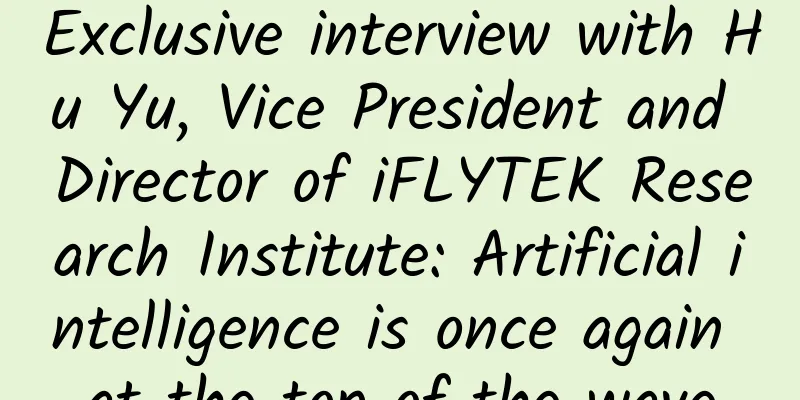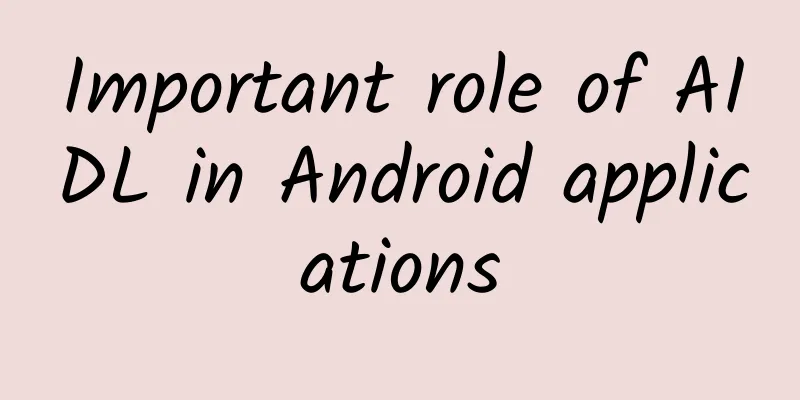Exclusive interview with Hu Yu, Vice President and Director of iFLYTEK Research Institute: Artificial intelligence is once again at the top of the wave

|
With the development of big data and cloud computing, artificial intelligence has once again been at the top of the wave. Products that claim to be artificial intelligence continue to emerge on the Internet, but most of them have become toys. The concept of artificial intelligence has been consumed again and again, but what is artificial intelligence? How to get rid of the state of being a toy? 51CTO interviewed Hu Yu, Vice President and Director of the Research Institute of iFLYTEK at the GMIC conference to explain to everyone what artificial intelligence is and the talent chain behind artificial intelligence. Why are we standing on the top of the wave again? If we count the time since the McCarthy and Rochester gathering in the summer of 1956, the concept of artificial intelligence has been proposed for nearly 60 years. In 1997, the "cumbersome" Deep Blue defeated the chess master and artificial intelligence stood on the top of the wave for the first time. After several twists and turns, with the development of mobile Internet, cloud computing, and big data in recent years, and the continuous influx of single products under the banner of artificial intelligence into the market, artificial intelligence has reached an unprecedented level of popularity this time. Hu Yu, vice president and director of the research institute of iFlytek, believes that there are three main reasons why artificial intelligence has become popular. The first is the improvement of core algorithms, among which deep learning is the overall breakthrough based on statistical models. Deep neural networks (DNN) and recurrent neural networks (RNN) can greatly improve the core algorithms of image and speech recognition. The second is the development and application of big data. Many aspects of current artificial intelligence are based on statistical models, and statistical models need data from real environments the most. It was difficult to collect enough samples in the laboratory environment in the past. With the development of big data, the amount of data is larger, more multi-dimensional, and covers a wider range. The third should be the establishment of a usage model. Compared with the original laboratory environment, current research technologies, products, applications, and end users are all connected in a complete chain, forming a closed-loop ecosystem of big data, mobile Internet, cloud computing, and intelligent applications, allowing each user to become a data contributor and experience sharer while enjoying the convenience brought by artificial intelligence. The establishment of core algorithms, big data, and application models provides the right time, right place, and right people for the development of artificial intelligence. The three parts of artificial intelligence Artificial intelligence is mainly divided into computational intelligence, perceptual intelligence, and cognitive intelligence. Perceptual intelligence includes speech recognition, handwriting recognition, and image recognition. Cognitive intelligence includes four aspects: language comprehension, knowledge representation, associative reasoning and autonomous learning. Hu Yu said frankly: "Compared with perceptual intelligence, cognitive intelligence's learning ability and knowledge mastery ability are the difficulties that need to be overcome at present, and we are still some distance away." Implementation Path The topic of achieving artificial intelligence by imitating the physiological principles of the human brain has been widely discussed since the concept of artificial intelligence was first proposed. McCullough, Turing, and even the famous mathematician von Neumann have explored this path, but in the end, they all failed due to the lack of environment at that time. Even now, the industry is still arguing about this. We won’t discuss whether it can succeed, but from an industry perspective, it seems unlikely to be feasible. Hu Yu also said in the interview: "There have been serious discussions internationally about simulating the human brain to achieve artificial intelligence, but it is not suitable for the breakthroughs that the current industry urgently needs. The EU's HBP and the US Human Brain Project are more aimed at medical applications rather than artificial intelligence." In traditional thinking, artificial intelligence requires a huge database for reasoning and application. With the development of big data and neural networks, people are now accustomed to using continuous probability statistics methods to describe the meaning of words through a mathematical relationship. Currently, Google and Microsoft are conducting research in this area, hoping to find new ways under the new system. If the problem of knowledge expression is solved within a few years, then natural understanding and logical reasoning will also be solved, and machines can learn by themselves. During the Spring Festival, a video of the conversation between a Shandong man and OnStar went viral online. When the driver corrected the number he said, OnStar continued to talk to itself and ignored the user's feedback. Hu Yu believes: "To a certain extent, this reflects the laboratory's self-willed approach, which has great problems in practical applications. If the machine understands the feedback information about the driver and conducts model thinking, such errors will not occur, but the system has not learned this information. The previous system construction did not have such an environment, and the current idea is to change - the system is not smart at the beginning, but by observing the user's feedback and extracting information from it, including the user's evaluation of the system, etc., it gradually becomes smarter, which requires new ideas and new methods to solve. Studying this method is a systematic science, and the realization of each point requires a team. It is necessary to master the most advanced technology, define a problem as a solvable engineering and scientific problem, and come up with an algorithm to optimize it. This requires a complete team, with students making high-risk attempts and researchers making feasible solutions. Such people are needed in the entire chain. If these problems can be solved, it will be possible to make machines have cognitive intelligence." AI Threat Theory Threat theories will arise with the application of every new technology, just like the privacy threat theory that accompanies big data. We get better services while selling out part of our privacy. Why not? The AI threat theory that comes with the emergence of artificial intelligence seems even more illusory, such as artificial intelligence destroying humanity... Hu Yu believes that this is something that only the rich and idle can do. Even if artificial intelligence technology has made a breakthrough, the machine will not have its own consciousness and emotions, nor will it consider whether it is harmful to humans or not. However, we have not even solved its most basic cognition and knowledge, so how can we talk about threats? From the rigorous perspective of scientists, it is uncertain whether it can be solved within ten years. Therefore, we should move forward step by step, design our products in reverse according to the current technical level, and think more about what problems our products can solve for everyone under the current technical conditions. It is somewhat alarmist to discuss the threat of artificial intelligence before the technology is realized. Instead of thinking about the threat in a backward way, we should think about what we need from artificial intelligence at present. Talent Strategy As mentioned above, artificial intelligence is a field that requires a large number of experts and top talents. It can be seen that Google and Baidu have been fighting for talent, and they have spared no expense in attracting veteran experts, outstanding graduates, and even teams that have begun to take shape. However, Hu Yu and iFLYTEK have different approaches to talent. Hu Yu said that there are three types of talents: the first is the foresighted university project leaders, the second is outstanding graduates, and the third is high-end talents who enter the iFLYTEK Research Institute. University teachers and industry experts are responsible for pointing out the direction for outstanding students, and with the help of iFLYTEK, students conduct some high-risk attempts, and finally the company's personnel produce low-risk, high-stability products. In terms of international talent strategy, Hu Yu mentioned: "iFLYTEK achieves the internationalization of talents through three ways. First, find the best experts in the field in the world to provide guidance. For example, the speech group of Bell Labs is the strongest in the world in acoustic technology, acoustic modeling and decoding algorithms. iFLYTEK established contact with the then head, Professor Li Jinhui, very early. Second, send people to internationally renowned research institutions. They must understand the company's needs and have access to the world's most advanced things. Third, actively carry out international exchanges and must participate in professional conferences in this field. At these conferences, you can really see the core of artificial intelligence, such as key algorithms that truly solve intelligent problems." There is no competition in the field of artificial intelligence Most people think that Baidu is iFlytek's biggest competitor in the field of artificial intelligence in China, but Hu Yu believes that "iFlytek and Baidu are not in a competitive relationship, but a cooperative relationship. They should jointly promote the industrial implementation of artificial intelligence in China. No company will compete in the field of artificial intelligence. They will jointly promote the healthy development of artificial intelligence. The real competition will be at the industry level." Hu Yu hopes that more and more companies will engage in artificial intelligence in China, so that more and more talents will gather. However, for the current artificial intelligence companies in China's information industry, everyone needs to make a louder voice together and correctly explain to the government or the majority of users the goals and paths that the current industry can achieve in artificial intelligence. This is good for cultivating the entire market and can establish a big momentum. It is also very important for China's international status in this field. Hope When the reporter asked, "What label do you hope people will give iFLYTEK in ten years?" Hu Yu said, "I think it should be a company that relies on technological innovation to gain user value and market value." |
<<: Testin APPBase: A head-to-head battle in the collaborative office app market
>>: Some technologies of Visual Studio Code come from Github
Recommend
The first course of the iP Evolution Wealth Camp of Tanhuo Video Account
The first issue of Tanhuo’s video account iP Evol...
Dadong Short Video Local Account Tutorial, including building ideas, layout production, copywriting content, editing operations, etc.
Dadong Short Video Local Account Tutorial, includ...
Product Operations: How to Essentially Explore Product Growth?
Don't panic when you encounter a cold winter....
AMD will launch a low-cost VR graphics card to lower the threshold for VR experience
[[167050]] Beijing time, June 1 morning news, AMD...
Is it true that loosening your belt after a meal can cause gastroptosis? How can foodies enjoy their meals happily?
A person who works hard to eat, a soul that works...
Is it complicated to develop an avatar creation app?
Whether it is a WeChat avatar, a QQ avatar, or an...
Insights into advertising media advertising trends in Q3 2021
As the current leaders in short video, Tik Tok an...
I spent 600 yuan in the morning and didn’t get any conversations, but my creative idea had a high click-through rate. How can I solve this problem?
Recently, I have received many messages from frie...
How long can the monopoly last? It’s time for Chinese AMOLED screen manufacturers to teach Samsung a lesson
ZTE recently released a folding smartphone that h...
How to do data analysis well? There are 5 key links!
In the era of big data and mobile Internet , ever...
WeChat: The mini-program jump to APP function has been abused and will no longer be supported
On May 14, WeChat issued a notice that "WeCh...
Promotion methods of APP new media marketing!
The basic tone of the APP operation and promotion...
Apple Dad’s 10 Marketing Skills That Won the “Outstanding Marketing Award”!
In the CMO Survey of global marketing executives,...
Momo information flow advertising types and promotion effects!
When we open the Momo app, we can see some advert...
Why can a small grating card allow people to experience a rich three-dimensional world?
A small card can show different pictures as you s...









